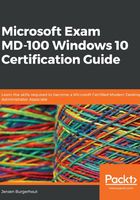
Summary
You have learned a lot in this chapter, including the difference between the three sorts of user accounts that can be logged into with Windows 10. In addition to that, you learned know how to create, modify, and delete local user accounts via Computer Management and PowerShell.
You saw which user accounts are created during the initial setup of Windows 10. We also covered local groups in this chapter, and you learned how to create, modify, delete, and rename local groups via Computer Management or PowerShell. As well as doing this, you are now familiar with which built-in local groups are created during the installation of Windows 10 and where these local users and local groups are stored on a computer. This will help you understand how you can administer local users and local groups.
Furthermore, we covered how to manage Windows 10 devices via Azure AD. Here, you configured Azure AD so that users can enroll their Windows 10, Android, or iOS devices into Azure AD. You then used different methods to connect a Windows 10 device to Azure AD, such as by registering and joining your organizational Azure AD tenant.
Once these devices are known in Azure AD, you can manage them via the Azure portal by disabling or deleting a device from Azure AD. This has helped you understand how you can connect and manage devices in Azure AD.
In the next chapter, we will learn how to configure NTFS permissions, share permissions, and configure file access.